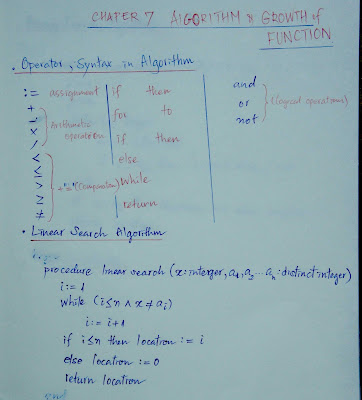แบบฝึกหัด
Algorithms
1. จงสร้าง algorithm เพื่อหาผลบวกของเลขจำนวนเต็มทุกตัวในรายการ(List)
-----------------------------------------------------------------
procedure Summation List(A1,A2,A3,.......,An : integers)
sum := A1 {set sum equal the value of first element}
for i := 2 to n
sum := sum+Ai {sum is the summation of all elements}
return sum {copy value of sum to function above}
-----------------------------------------------------------------
2.จงเขียน algorithm เพื่อเปลี่ยนค่าตัวแปร x และ y โดยใช้การกำหนดค่า (assignments) เพียงอย่างเดียว และตอบว่าต้องใช้การ
กำหนดค่ากี่ครั้ง
-----------------------------------------------------------------
procedure exchange value (x,y : integers)
A := x { 1times }
x := y { 1times }
y := A { 1times }
-----------------------------------------------------------------
Answer : Time Complexity is 3 times
-----------------------------------------------------------------
3.จงเขียน algorithm เพื่อหาตำแหน่งของตัวเลขที่มีค่ามากที่สุดตัวเลขแรกในลิสต์ของจำนวนเต็ม โดยเลขจำนวนเต็มในลิสต์อาจซ้ำกันได้
-----------------------------------------------------------------
procedure location of max(A1,A2,A3,......,An : integers)
max := A1 {set max equal the first element}
for i := 2 to n {do loop location of element from 2 to n}
if Ai > A1 then max := Ai {consider to the value of max}
location := i {copy location of max element}
return location
-----------------------------------------------------------------
4.จงเขียน algorithm ที่จะนับจำนวนเลข 1 ในบิตสตริงโดยพิจารณาแต่ละบิตของสตริงเพื่อตรวจสอบว่าเป็นเลข 1 หรือไม่
-----------------------------------------------------------------
procedure Number of 1digit(A0,A1,A2,.....,An-1:character)
{string array of An-1 = \o is NULL so we didn't count it}
count := 0
for i := 0 to n-2
if Ai := 1 then count := count + 1 {add to count 1 if Ai = 1}
return count
-----------------------------------------------------------------
5.จงแสดงว่าฟังก์ชั่นที่กำหนดให้ ข้อใดเป็น O(x2)
a.f(x)=17x+11
-----------------------------------------------------------------
method of Big-O : |f(x)|<=c×|g(x)| ; x>=k
17x+11 <= c×x² ; x>=k
17x+11 <= 17x²+11x² when x >=1
17x+11 <= 28x² when x >=1
=> c = 28 , k = 1
So : f(x) = 17x+11เป็น O(x2) #
-----------------------------------------------------------------
b.f(x)= x2+1000
-----------------------------------------------------------------
method of Big-O : |f(x)|<=c×|g(x)| ; x>=k
x²+1000 <= c×x² when x >= k
x²+1000 <= x²+1000x² when x >= 1
x²+1000 <= 1001x² when x >= 1
=> c = 1001 , k = 1
So : f(x) = x²+1000เป็น O(x2) #
-----------------------------------------------------------------
c.f(x)=x4/2
-----------------------------------------------------------------
we knew that f(x) is not big-o of x² so we use converse proof by
proof x²=O(f(x)) if true mean that f(x) != O(x²) :
method of Big-O :
x² <= c×x4/2 when x >= k
x² <= 2×x4/2 when x >= 1
=> c = 2 , k = 1
So : f(x) = x4/2ไม่เป็น O(x2) #
-----------------------------------------------------------------
6.จงแสดงว่า 10n+8 เป็น O(n)
-----------------------------------------------------------------
method of Big-O :
10n+8 <= c×n when x >= k
10n+8 <= 10n+8n when x >= 1
10n+8 <= 18n when x >= 1
=> c = 18 , k = 1
So : 10n+8 เป็น O(n) #
-----------------------------------------------------------------
7.จงแสดงว่า n2+1 เป็น O(n2)
-----------------------------------------------------------------
method of Big-O :
n²+1 <= c×n² when x >= k
n²+1 <= n²+n² when x >= 1
n²+1 <= 2n² when x >= 1
=> c = 2 , k = 1
So : n²+1 เป็น O(n²) #
-----------------------------------------------------------------
8.จงแสดงว่า f(n) = n2 + 2n + 1 เป็น O(n2)
-----------------------------------------------------------------
method of Big-O :
n²+2n+1 <= c×n² when x >= k
n²+2n+1 <= n²+2n²+n² when x >= 1
n²+2n+1 <= 4n² when x >= 1
=> c = 4 , k = 1
So : n²+2n+1 เป็น O(n²) #
-----------------------------------------------------------------
9.จงแสดงว่า f(n) = 4n3+2n2+n+5 คือ O(n3)
-----------------------------------------------------------------
method of Big-O :
4n³+2n²+n+5 <= c×n³ when x >= k
4n³+2n²+n+5 <= 4n³+2n³+n³+5n³ when x >= 1
4n³+2n²+n+5 <= 12n³ when x >= 1
=> c = 12 , k = 1
So : 4n³+2n²+n+5 เป็น O(n³) #
-----------------------------------------------------------------
































